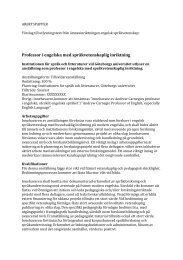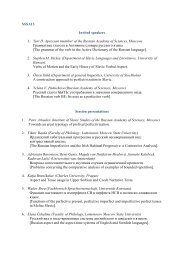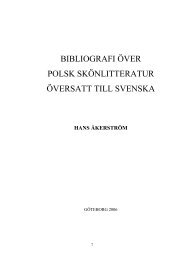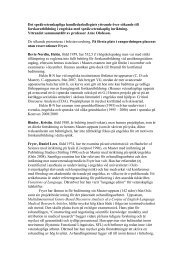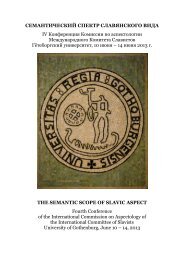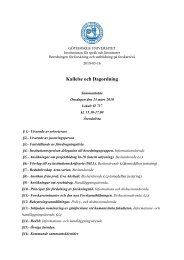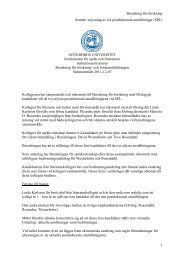Although some space for improvisation is deliberately included in Minna’s music, it isprimarily melodic and fully composed with clear forms. My application of the model toMinna’s music is offered below:Figure 7: PACT-Helsinki Koto Ensemble<strong>Cultural</strong> translation and MusicPentagonal Analysis of <strong>Cultural</strong> Translation (PACT)Musical Example: Minna Padilla and Helsinki Koto Ensemble<strong>Cultural</strong> Origins: Japanese Traditional Music / Contemporary FinnishFolk MusicSalience ofSpecific Domain: Hybridity:[ Strong / Med / Weak ]Explanation/Evidence:A) Technological Adaptations StrongB) Idiomatic Conventions MediumC) Aesthetic Notions StrongIndigenous folk instruments from two continents, recenttechnologies used in recording studio.Melodic and harmonic influences are traceable to both Japanese andFinnish traditions.“Flavor” and syncretism of contemporary Finnish folk music withJapanese artistic traditions.D) Creative Practices Strong Fully composed, yet some improvisational elements.E) Receptive Contexts Strong Embassy-affiliated performances, concerts in Japan and Europe.Figure 7: PACT-Helsinki Koto EnsembleTokyo Brass StyleHiroshi Watanabe, a Professor of Aesthetics at Tokyo University, has argued that mixed or hybridTokyo musics, Brass particularly Style indigenous brass bands, offer an important way of understanding Japanesecultural identity in the globalized contemporary world. Although Watanabe’s analysis spe-Hiroshi Watanabe, a Professor of Aesthetics at Tokyo University, has argued that mixedor hybrid musics, particularly indigenous brass bands, offer an important way ofcifically refers to the earliest examples of western hybridized music in Japan, I have extended onunderstanding Japanese cultural identity in the globalized contemporary world. Althoughsuch Watanabe’s assertions analysis in previous specifically projects to refers demonstrate to the earliest how the examples kind of wind of bands western most hybridized commonlyencountered music in Japan, in Japan’s I have educational extended system on such are assertions also particularly in previous important projects in terms to demonstrateof contemporaryhow the cultural kind identity. of wind 30 bands Watanabe most has commonly observed that encountered “in each location in Japan’s around educational the world, with systemthe are natural also particularly mixing of local important music fusions, in terms truly of diverse contemporary brass bands cultural have come identity. into 33 existence. Watanabe hasRecently, observed with that the “in progress each location of research around into these world, kinds of with bands, the it natural becomes mixing clear that of local the particularfusions, cultures truly of diverse various brass non-western bands have regions, come facing into the existence. invasion of Recently, Western culture, with the have progress skil-musicfullyof researchadapted withintomodernitythese kindstoofbearbands,livingitwitnessbecomesto ancleararraythatof distinctthe particularculturalculturesidentities.”of 31various non-western regions, facing the invasion of Western culture, have skilfullyWatanabe’s perspective is quite interesting to consider in light of one of the most high-profileadapted with modernity to bear living witness to an array of distinct cultural identities.” 34recent developments in the field of wind music fusions in Japan, Tokyo Brass Style, also knownWatanabe’s perspective is quite interesting to consider in light of one of the most highprofile“Brasta.” recent 32 This developments is a band comprised in the entirely field of of wind young music women fusions who perform in Japan, original Tokyo arrange-Brassasments Style, on also brass known and percussion as “Brasta.” instruments. 35 This is “Anijazz,” a band comprised fusing anime entirely and jazz, of is young one term women widely whoused perform to explain original what arrangements Brasta actually on plays: brass a kind and of percussion “jazzy” hybrid instruments. instrumental “Anijazz,” arrangement fusingof familiar tunes and songs from Japanese anime and videogames that have been popular acrossrecent 33 DavidyearsG. Hebert,amongAlchemycontemporaryof Brass:JapaneseSpiritualityyouth.andTheirWindperformanceMusic in Japan,styleEdwinis utterlyMichaelexuberant,244; replete David with G. Hebert, “kawaii” “The gestures Tokyo Kosei and enthusiastic Wind Orchestra: youthful A case energy. study of In intercultural many respects, music I wouldRichards andKazuko Tanosaki, eds., Music of Japan Today (Newcastle: Cambridge Scholars Publishing, 2008), pp.236-transmission,” Journal of Research in Music Education, 49(3) (2001), pp. 212-226.argue, 34 their approach to hybridity echoes patterns of musicianship that may be traced more thanHiroshi Watanabe, “Kangaeru Mimi,” Mainichi Shinbun (14 September, 2005) [my translation incollaboration with Dr. Hiro Shimoyama, physicist].35 Tokyo Brass Style, http://www.brasta.jp/30 David G. Hebert, Alchemy of Brass: Spirituality and Wind Music in Japan, Edwin Michael Richards andKazuko Tanosaki, eds., Music of Japan Today (Newcastle: Cambridge Scholars Publishing, 2008), pp.236-244; David G. Hebert, “The Tokyo Kosei Wind Orchestra: A case study of intercultural music transmission,”17Journal of Research in Music Education, 49(3) (2001), pp. 212-226.31 Hiroshi Watanabe, “Kangaeru Mimi,” Mainichi Shinbun (14 September, 2005) [my translation in collaborationwith Dr. Hiro Shimoyama, physicist].32 Tokyo Brass Style, http://www.brasta.jp/35
anime and videogames that have been popular across recent years among contemporaryJapanese youth. Their performance style is utterly exuberant, replete with “kawaii”gestures and enthusiastic youthful energy. In many respects, I would argue, theirapproach to hybridity echoes patterns of musicianship that may be traced more than acentury in the past to the “jinta” and other early westernized wind and percussiona century in the past to the “jinta” and other early westernized wind and percussion ensemblesensembles in Japan that adopted local folk melodies. 36 Brasta appears to have arisen quitein Japan that adopted local folk melodies. 33 Brasta appears to have arisen quite organically, andorganically, and its musical approach is to freely adapt the songs most familiar toits Japanese musical approach youth to is the to kinds freely adapt of western the songs instruments most familiar commonly to Japanese taught youth in to Japanese the kinds schools. ofwestern Notable instruments examples commonly of Brasta taught songs include Japanese their schools. popular Notable performance examples of Brasta “Maka songs Fushigiinclude Adventure” their popular from the performance Dragon Ball of “Maka videogame, Fushigi Adventure” (derived from manga the Dragon and Ball anime), vide-aogame, as BrastaGhibli, (derived from a recent manga and album anime), devoted as well entirely as BrastaGhibli, to brass arrangements a recent album of devoted music entirely fromwellto Hayao brass arrangements Miyazaki’s beloved of music epic from anime Hayao Miyazaki’s adventure beloved films (Studio epic anime Ghibli adventure productions). films (Studiofollowing Ghibli productions). figure illustrates The following application figure of illustrates the model application to Tokyo of Brass the model Style: to TokyoTheBrassStyle:Pentagonal Analysis of <strong>Cultural</strong> Translation (PACT)Musical Example: Tokyo Brass Style<strong>Cultural</strong> Origins: Contemporary Japanese Youth Culture(anime/gaming) / European Brass & Latin Dance Band (ska/salsa)Specific Domain:A) Technological Adaptations WSalience ofHybridity:[ Strong / Med / Weak ]Figure 8: PACT-Tokyo Brass StyleFigure 8: PACT-Tokyo Brass StyleMoscow Pan-Asian EnsembleExplanation/Evidence:Little new here considering the origins: Japanese school bandadaptations of global band traditions combined with Japanese youthculture influences (anime, videogame music, etc.).B) Idiomatic Conventions M Mastery of Latin styles; strong musical skills with unique image.C) Aesthetic Notions M“Phantasm”? Traditional notions of Japaneseness may be irrelevanthere. Outstanding performance technique on complex arrangementsof seemingly simplistic tunes.D) Creative Practices S Very original arrangements, effective improvisation.E) Receptive Contexts M Performances in nightclubs and workshops in schools.The Moscow Pan-Asian Ensemble (previously known as Wa-On Ensemble) is another examplewell Moscow worth consideration. Pan-Asian Ensemble In 2003, I performed and recorded a few times on trumpet and voicewith The this Moscow unique Pan-Asian free improvisation Ensemble ensemble (previously at the Tchaikovsky known as Wa-On Conservatory Ensemble) while I is was another livingexample well worth consideration. In 2003, I performed and recorded a few times onin Moscow and employed as a lecturer for Lomonosov Moscow State University. The Pan-Asiantrumpet and voice with this unique free improvisation ensemble at the TchaikovskyEnsemble is led by expert Russian musicians trained in composition, ethnomusicology, and musicMoscow therapy, State and who University. are especially The inspired Pan-Asian by Asian Ensemble music, is particularly led by expert Japanese Russian traditional musicians mu-Conservatory while I was living in Moscow and employed as a lecturer for Lomonosovsic. trained On the in JazzLoft composition, website, ethnomusicology, the Moscow Pan-Asian and Ensemble music therapy, is described and who as follows: are especiallyinspired “Pan-Asian by Asian Ensemble music, is particularly led by Georgy Japanese Mnatsakanov traditional (shakuhachi) music. and Dmitry On the Kalinin JazzLoft (shakuhachi,the hichiriki, Moscow Chinese Pan-Asian gong-chimes Ensemble and voice). is The described Ensemble is as augmented follows: by Varvara Sidoro-website,va, Kakujo Nakagawa and Misako Mimuro (all three on biwas) and Pyotr Nikulin on dijeridu and36 Dmitry Schyolkin on percussion. The leaders studied with great Japanese teachers. Amazingly, theShuhei Hosokawa, “Nihonno geinou 100nen: Jinta” Miyujikku Magajin, (1990, January), pp.103-107.Russians try to create new music based directly on Japanese musical traditions and its aestheticprinciples without distorting European composing techniques. Amazingly, they manage to createsomething truly original.” 3418In fact, both Mnatsakanov and Kalinin are highly accomplished shakuhachi players, each of3633 Shuhei Hosokawa, “Nihonno geinou 100nen: Jinta” Miyujikku Magajin, (1990, January), pp.103-107.34 http://www.jazzloft.com/p-45603-mujou.aspxDavid G. Hebert
- Page 1: Cultural TranslationsProceedings of
- Page 4 and 5: PrefaceThe idea of organizing a wor
- Page 6 and 7: ContentsAcknowledgementIIPrefaceIII
- Page 8 and 9: Literature and Transculturality:Som
- Page 10 and 11: agenda of Herder, which was to figh
- Page 12 and 13: nomenon. However, until long into t
- Page 14 and 15: Tawada’s work appeared in Swedish
- Page 16 and 17: multiple interpretations. Japan is
- Page 18 and 19: Cultural Translation between Tradit
- Page 20 and 21: George P. Murdock illustrated the p
- Page 22 and 23: ancestor of the Maori arrived in Ao
- Page 24 and 25: nal names do not necessarily have.
- Page 26 and 27: One of the functions of ‘cultural
- Page 28 and 29: PRELUDEIn 2003, an original artisti
- Page 30 and 31: planted, adopted and fused with ind
- Page 32 and 33: liest known written clues regarding
- Page 34 and 35: since there are many Asians and Pac
- Page 36 and 37: listening to and evaluating sounds
- Page 38 and 39: Ensemble, and the Moscow Pan-Asian
- Page 40 and 41: temporary Finnish folk music. 29I a
- Page 44 and 45: whom have devoted many years to ser
- Page 46: POSTLUDEBy way of conclusion, allow
- Page 49 and 50: IntroductionThe aim of this paper i
- Page 51 and 52: to discuss what role Japan was to p
- Page 53 and 54: I may be allowed henceforth to use
- Page 55 and 56: program was to promote and help stu
- Page 57 and 58: 50different of that of Millán -Ast
- Page 59 and 60: most impracticable people in the ea
- Page 61 and 62: intending to give the Book a quasi
- Page 63 and 64: understood by the West on a time wh
- Page 65 and 66: FUJIWARA Masahiko. (2008) Kokka no
- Page 67: - (2002) Cultural light, political
- Page 70 and 71: Translation, or better, linguistic
- Page 72 and 73: one may not expect anything other t
- Page 74 and 75: as Murakami opts for a globalized v
- Page 76 and 77: market. 17 Another indispensable to
- Page 78 and 79: (This is part of my doctoral thesis
- Page 80 and 81: elieve advances man’s progress he
- Page 82 and 83: ender the New Testament into Japane
- Page 84 and 85: a synonym for kami. The latter is a
- Page 86 and 87: The American school text is in the
- Page 88 and 89: Willson Reader 46 T73 47I will not
- Page 90 and 91: Gentlzer, Edwin & Tymoczko, Maria 2
- Page 92 and 93:
Tea ceremony or tea cult?Translatin
- Page 94 and 95:
Company (VOC), men came from differ
- Page 96 and 97:
H. Stolpe gathered items in Japan f
- Page 98 and 99:
simple presentations had negative i
- Page 100 and 101:
theticism, with its manifold bearin
- Page 102 and 103:
Kumakura, Isao (1980) 近 代 茶
- Page 104 and 105:
1. Introduction and aim of the pape
- Page 106 and 107:
main character and the caller doesn
- Page 108 and 109:
not” and ”at present” that ha
- Page 110 and 111:
match this name, a sea as artificia
- Page 112 and 113:
I John Gabriel BorkmanHenrik Ibsen
- Page 114 and 115:
his dream during the 1870s, when ca
- Page 116 and 117:
make a decision. But it turns out t
- Page 118 and 119:
Ôgai’s change of translation str
- Page 120 and 121:
Behind every utterance lies two mot
- Page 122 and 123:
a large group of persons be gathere
- Page 124 and 125:
The “Territory of Translation”
- Page 126 and 127:
八 十 日 間 世 界 一 周 :
- Page 128 and 129:
heuristic tools, especially conside
- Page 130 and 131:
Left: Photo of Kawashima Chūnosuke
- Page 132 and 133:
Burlington Gardens is in London (Ro
- Page 134 and 135:
門 アリ 入 リテ 見 レバ
- Page 136 and 137:
scene seems to be merely one of man
- Page 138 and 139:
Niwa Jun’ichirō’s Spring Tale
- Page 140 and 141:
The text is full of detailed descri
- Page 142 and 143:
where the narrative voice does not
- Page 144 and 145:
The reason the “territory of tran
- Page 146 and 147:
Translating the Trip Around the Wor
- Page 148 and 149:
ForwordI have been working on my do
- Page 150 and 151:
clining though. By the end of 1980
- Page 152 and 153:
幸 い 神 の 怒 りは 鎮 ま
- Page 154 and 155:
The Public Sphere as Deliberation o
- Page 156 and 157:
and absence of hierarchy would have
- Page 158 and 159:
was used much like we would use “
- Page 160 and 161:
outcasts and bandits - were suppose
- Page 162 and 163:
cal sense, the arena where particip
- Page 164 and 165:
society” and in which “there wa
- Page 166 and 167:
sic formulations, the public sphere
- Page 168 and 169:
はじめに日 本 統 治 下 の
- Page 170 and 171:
似 地 一 下 一 下 拽 那 鼻
- Page 172 and 173:
ということから、 古 丁
- Page 174 and 175:
の「 序 」で、 大 東 亜
- Page 176 and 177:
3.1 翻 訳 と 満 洲 国 語 政
- Page 178 and 179:
取 り 入 れを 主 張 する
- Page 180 and 181:
文 化 の 翻 訳 としての「
- Page 182 and 183:
史 性 にも 留 意 すべきだ
- Page 184 and 185:
て、 渦 巻 きよりほかは
- Page 186 and 187:
変 わらないということも
- Page 188 and 189:
訳 語 と 新 語 から 見 る
- Page 190 and 191:
しは「 無 為 」や「 本 性
- Page 192 and 193:
思 想 を 基 礎 として、
- Page 194 and 195:
って「 物 理 上 哲 学 」
- Page 196 and 197:
し、まさにはこの 時 期
- Page 198 and 199:
意 譯 : 理 學 、 性傅 汛
- Page 200 and 201:
柴 田 昌『 增 補 訂 正 英
- Page 202 and 203:
一 八 七 七 年 、 文 部 省
- Page 204 and 205:
日 中 友 好 の 象 徴 「 鑑
- Page 206 and 207:
と 指 摘 した。成 吉 思
- Page 208 and 209:
をあげている。さらにま
- Page 210 and 211:
に 請 ひて 出 家 を 求 む
- Page 212 and 213:
この 時 奉 請 の 十 師 等
- Page 214 and 215:
歴 史 小 説 『 天 平 の 甍
- Page 216 and 217:
点 」が 生 じたと 指 摘
- Page 218 and 219:
まず、 昨 今 、 活 発 に
- Page 220 and 221:
2、 従 来 の 比 較 文 学 (c
- Page 222 and 223:
普 遍 理 論 を 適 用 し、
- Page 224 and 225:
ス・テグネル(Esaias Tegnér,
- Page 226 and 227:
に 満 ちる「 生 命 」に
- Page 228 and 229:
う 形 をとって 展 開 した
- Page 230:
学 が 大 学 で 展 開 して



